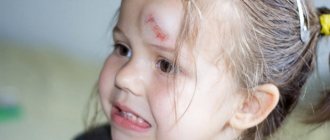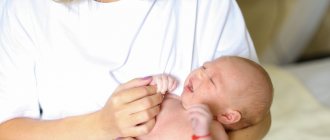Consultation with a neurologist – RUB 1,750.
Fainting is characterized by a short loss of consciousness resulting from disruption of blood circulation in the brain.
Reasons that can cause this condition include:
- a sharp drop in blood pressure when the body is unable to adapt and compensate for it;
- a decrease in the volume of blood circulating in the body as a result of massive bleeding or excessive fluid loss;
- the occurrence of involuntary nerve impulses in the brain during an unexpected stressful situation;
- an increase in carbon dioxide content in the body and a decrease in oxygen concentration, for example, in stuffy rooms;
- disruption of blood flow to a separate area of the brain, for example, with a mini-stroke.
According to the mechanism of occurrence, fainting is divided into:
- cardiogenic - this type occurs in the presence of cardiovascular pathology;
- cerebrovascular – more typical for older people and are associated with the occurrence of ischemia (local decrease in blood flow in a region of the brain);
- reflex – the cause is strong psycho-emotional disorders;
- orthostatic - insufficiency of vascular reflexes, for example, with a sudden change in body position.
Symptoms
The following signs are warning signs of fainting:
- pale skin and sweat on the skin;
- dizziness and ringing in the ears;
- darkening or flickering in the eyes;
- increased heart rate;
- feeling of heat.
Also, the pre-fainting period is characterized by rapid breathing and yawning. In this way, the body tries to compensate for the oxygen deficiency.
Loss of consciousness lasts from several seconds to minutes and is accompanied by a decrease in muscle tone and a drop in blood pressure. Possible addition of isolated convulsions.
How treatment and preventive measures are carried out
When identifying the true causes of fainting, it is important to eliminate them, then there will be no fainting states. Among general activities, it is imperative to follow a daily routine, strictly monitor timely food intake and proper sleep. Nutrition should be age-appropriate, rich in all essential nutrients, minerals and vitamins; a sufficient supply of light carbohydrates is also important.
It is useful to do morning exercises, go to the pool, play sports, but do not overwork. For children with high excitability, baths with sedative herbs and sea salt are useful. In case of abnormalities in the ECG, drugs are used that nourish the heart muscle and the underlying diseases are treated.
Alena Paretskaya, pediatrician, medical columnist
5, total, today
( 60 votes, average: 4.92 out of 5)
Chest injuries, fractures of the sternum and ribs: symptoms and first aid
Acute coronary syndrome: diagnosis and emergency care
Related Posts
Treatment
First aid for fainting consists of clearing the airways and placing the patient on a flat surface with the legs raised and the head turned to the side to prevent the tongue from retracting. The elevated position of the lower extremities will help increase blood flow to the brain. Irritating substances are also used, for example, ammonia or cold water on the face.
Drug therapy is based on the use of drugs that increase blood pressure and vascular tone, such as cordiamine and ephedrine.
Syncope. (Fainting. Causes of fainting)
Authors : Utin A. G.
Aristotle argued that a person has 5 senses - touch, smell, vision, hearing, taste. Now we know that a person has at least 9 feelings (some, in their passion, call the number 21). In addition to the five listed: 6) thermoception (sense of heat/cold), 7) equibrioception - sense of balance, proprioception or tendon sense (helps to understand where your leg (hand, tail) is currently located, even with your eyes closed), 9) nociception - perception of pain, etc. There are people who are deprived of one of the senses. And many of us lost all nine at once (on the 21st). Today I will tell you about fainting.
Now we know that a person has at least 9 feelings (some, in their passion, call the number 21). In addition to the five listed: 6) thermoception (sense of heat/cold), 7) equibrioception - sense of balance, proprioception or tendon sense (helps to understand where your leg (hand, tail) is currently located, even with your eyes closed), 9) nociception - perception of pain, etc. There are people who are deprived of one of the senses. And many of us lost all nine at once (on the 21st). Today I will tell you about fainting.
Most people's brain makes up 2% of their body weight. In this case, the brain receives 20% of the cardiac output. The human brain has its own pressure regulation system, which maintains normal, uniform blood circulation if the systemic systolic pressure is not lower than 60 mm. Hg Art. and not higher than 160 mm. Hg Art. If you experience weakness, dizziness, ringing in the ears, paleness, darkening of the eyes, mild nausea, excessive salivation and sweating, if you almost faint or have fainted, first measure your blood pressure. Most likely it will be lowered. For some reason, many people think that such symptoms accompany increased blood pressure and take an Andipal (Capoten, Corinfar) tablet under the tongue, a pressure-reducing tablet. On the advice of a neighbor, Anastasia Filippovna. Just measure your blood pressure before taking the pill. Many people believe that fainting is a sign of a stroke. Friends, if you had a stroke and passed out, you wouldn't wake up on your living room floor, rubbing a bump from hitting the Italian marble floor. At a minimum, you wouldn't be able to move your arm or leg, talk, or anything else. There would be something else other than a bump. The cause of the bump is tiles and gravity. When systolic pressure is below 60 mm. Hg Art., then adequate blood supply to the brain stops and the person loses consciousness. Faints. Let's look at the causes of fainting. Fainting may be associated with heart problems. The heart, for some reason, stops performing its pumping function and maintaining normal blood pressure. The structure of the heart may be damaged. This may be hypertrophic cardiomyopathy, aortic valve stenosis, pulmonary artery stenosis, primary pulmonary hypertension, atrial myxoma, spherical thrombus in its cavity, etc. These names won't tell you anything early on. It is necessary to do an echocardiography (“ultrasound of the heart”). This study will help you understand the cause of fainting, so as not to read too much on Wikipedia. There may be cardiac dysfunction. Heart rhythm disturbances. Many people perceive the word “arrhythmia” as a diagnosis. I will write about this later. Arrhythmia is a rhythm disorder. This is a huge group of heart diseases, from the most harmless (extrasystole) to fatal (ventricular fibrillation). Saying “I have an arrhythmia” to a doctor is the same as saying “I have pain.” “What hurts you,” “what type of arrhythmia do you have,” the doctor will definitely ask. High degree atrioventricular block, sick sinus syndrome, ventricular fibrillation, ventricular tachycardia, WPW syndrome, etc. – causes of arrhythmogenic syncope. Their darkness. To understand what arrhythmia caused the fainting, you need to “take an ECG” directly during the fainting. Few people have the opportunity to join the cardiograph in a pre-fainting state. Registration of an ECG at rest, after fainting, may be completely uninformative. In 1961, American biophysicist Norman Holter introduced a 24-hour ECG monitoring device into clinical practice. Registration of an ECG during the day makes it easier to find the cause of fainting. Of course, the arrhythmia itself may not be registered, but you can see the ECG prerequisites for its occurrence. To diagnose particularly hidden arrhythmias, an ECG recorder is implanted into the human body for several months. Finally, arrhythmia can be provoked by electrical discharges of different frequencies, directly through a catheter inserted into the heart, or through the esophagus. This is an electrophysiological study. Friends, sinus tachycardia and extrasystole (what you most often call “arrhythmia”) can almost never be the cause of fainting! For reasons of the heart, I hope it’s clear. They are very dangerous and always have a serious prognosis. The second large group of causes is vascular. Atherosclerosis of the vessels of the neck and head, in combination with cervical osteochondrosis, leads to loss of consciousness when turning, and especially when throwing back the head. This is a symptom of the Sistine Chapel. Looking at the frescoes on the ceiling leads to compression of the altered vertebral arteries by the altered processes of the vertebrae, the blood supply to the brain is disrupted and the person falls to the floor, seemingly from an excess of aesthetic experiences. Duplex examination of the brachiocephalic arteries and x-ray of the cervical spine will help us in diagnosis. Orthostatic hypotension is one of the most common causes of fainting. During a sharp transition from a horizontal to a vertical position, the blood “leaves” from the head to the feet, and the person loses consciousness. This occurs due to detraining or an unbalanced state of the unequal autonomic system (in our country this condition is often called “vegetative-vascular dystonia”), when, in response to the redistribution of blood flow, corresponding changes in vascular tone do not occur. During evolution, humans have developed 2 types of reactions to stressful situations. Type 1 is associated with the release of adrenaline - an increase in blood pressure, a rush of blood to the muscles for fight and flight. Type 2, less common, is a sharp drop in blood pressure and fainting. The evolutionary meaning is that a predator or enemy will not touch an imaginary dead body. Which method is better is up to you to decide. But this is how vasodepressor syncope occurs. Fainting associated with a reflex drop in blood pressure in response to stress. The most common and most harmless. The cause of vasodepressor syncope can be a decrease in blood pressure during blood sampling, dental treatment, fatigue, lack of sleep, being in a stuffy room, etc. Reflex fainting can also occur with coughing, irritation of the larynx, carotid sinus, or defecation. But they occur much less frequently. Fainting may be caused by a decrease in circulating blood volume due to bleeding, vomiting, diarrhea, or taking diuretics. If you have discomfort in the chest area, your neighbor Nastasya Filippovna may advise you to take a nitroglycerin tablet. Nitroglycerin, the most common cause of drug-induced fainting, causes a powerful decrease in blood pressure. Bonus: severe headache. There is no need to take nitroglycerin unless indicated. There are a number of conditions that mimic fainting: 1. hypoglycemia (low blood sugar) - in diabetic patients taking insulin - in crazy bodybuilders who use insulin as a means of increasing the production of growth hormone The main signs of hypoglycemia are a feeling of hunger and, very abundant, sweating 2. Epileptic seizure. (usually accompanied by convulsions. After a seizure, the person is very inhibited and does not have the pallor characteristic of fainting). 3. Hysterical seizure (patients fall neatly and beautifully, always “in public”, there is no pallor, they can imitate convulsions (complex and elaborate bends and poses)) Now about the main thing. If you faint, of course, you don’t need to immediately run and sew a heart rate recorder into yourself. First of all, you need to establish whether the fainting was a response to a stressful situation or physical exhaustion (pain, the sight of blood, a stuffy room). Think about the medications you took (nitroglycerin, diuretics, blood pressure medications). If fainting occurs during the transition from a horizontal to a vertical position (sharp rise), then, most likely, complex examinations will not be required. You should be concerned about fainting that occurs suddenly, without an obvious reason, especially when lying down. Most likely, these fainting spells are associated with rhythm disturbances. Hypotonic people faint at every opportunity: after a sauna, in stuffy rooms, at dentist appointments. This won't surprise us. Lay him on the couch, raise his legs up and wait for him to come to his senses. But, if a hypertensive patient has lost consciousness, if he has coronary heart disease or some other heart disease, call an ambulance. If he survives, he must be carefully examined for arrhythmias, carotid atherosclerosis, cardiomyopathy, and pulmonary embolism.
Source
published 01/28/2014 09:34 updated 02/07/2015 — Heart and vascular diseases, Miscellaneous, Cardiology, Miscellaneous
Loss of consciousness in children
Maria
Hello, all the mothers who came to this page have probably encountered something similar and are now scrolling through the Internet with trembling hands in search of an answer.
I am the mother of a daughter who fell out of her crib at 9 months old, dad didn’t watch it, and after that it all started! I am now spending time sitting here, registering, etc., to reassure and warn many mothers from the mistakes that they can make due to the negligence and lack of education of many doctors! After this fall, we got what most parents who have more emotional children than everyone else, 1 - crying, 2 - FULL exhalation after which a spasm of the respiratory tract occurs, 3 - rolled eyes, 4 - facial spasm (not twitching, namely squeezes and holds for a few seconds), 5 - cyanosis (in some cases, some children have a white appearance), 6 - often the hands look like an arch or a hook at the bottom, 7 - loss of consciousness - the most dangerous in terms of injury (may fall and seriously hurt yourself on something ) and after all this, which in a normal case lasts from 20 to 60 seconds before the child leaves, the parents, in a semi-infarction state, almost die, get a full, sleepless night, and the fear of sending the child to kindergarten, grandmother, etc., and this is the beginning, then a bunch of doctors... And from this point in more detail!!!! We are one of those parents who were in the regional children's hospital, had an MRI, ECG, ECG, ultrasound through the fontanelle, encephalogram, and a bunch of other things! And this chapter is “shit” in my head, it says it’s EPILEPSY and I wrote a bunch of medications according to the usual list for epilepsy without even bothering, we are in shock, to put it mildly, tears in our eyes and semi-cardiac arrest! We're going to another doctor, then another one at 5!!! And over the course of these six months, these attacks occur even if the child does not want to leave the playground and, crying, gets another attack, and did not even receive candy or a doll, and then 4 attacks!!! (((and we, thank God saved us Because of a mistake, we did not take drugs for epilepsy, but would have made our child disabled for life with our own hands! I gave herbal sedatives 3 times a day, and only now, after 5 years, I realized what it was. This is - AFFECTIVE RESPIRATORY ATTACK Dear mothers, spend 30 minutes and do not maim your children, be calm and love your children, good health to all the little inhabitants of our planet!!! [Link removed]l It looks something like this: do not be confused if your face or hands are twitching or something else, it could be an epi attack, and timely contact with doctors and treatment is the key to success, I’m only talking about my case and an AFFECTIVE RESPIRATORY ATTACK And by the way, the encephalogram showed us in the occipital region the threshold for convulsive readiness was reduced, MRI - the brain is unchanged, and our child is very emotional and very active. And this lasted for us from 9 months to 1.5 years 5 times, from 1.5 to 3.5 often, then from 4 to 6 about 3-2-1 times a year! The main thing is that it has started to decline! And now there’s only a very strong pain after emotional stress, and also a sore throat and before that I fell in a heap and climbed into the car and hit my head hard, that’s what happened, and the most IMPORTANT thing, I almost forgot, the golden rule, don’t tap the child , believe me, this is stupid, I did it out of ignorance, it has not been tested effectively.!!((but WATER!!! YES WATER is your assistant, a cup of water on your head or face, don’t be afraid, then change into your T-shirt for the best , and it helps very quickly, and if you see that you have already started crying, then you immediately poured it into the bathtub under the tap or poured a bottle on your head and that’s it, sometimes you had to spit in your face, but what to do((!!! But remember one thing, it’s better to try to distract, and prevent an unplanned “washing” later)! And in kindergarten, warn them, otherwise the teacher will still have a heart attack. The most important thing is that children will not suffer from an attack if they do not fall and seriously hit themselves, that is, with consequences such as a broken head or knocked out teeth, and then new teeth will grow at 6!) so don’t be too nervous, because the health of the parents is not least important for the child, because it’s good that you are nearby and not in the hospital! It seems like everything!!) phew, I wrote it, my eyes are already on my forehead)! Peaceful dreams to everyone, and about cartoons, the main thing is that they are kind and calm, and do not strain the baby’s nervous system!!! I have 5 taboos for my daughter, these are: here and there, ninja go, ogi and cucaracha, and a couple more, track down what makes your child overexcited. Sorry for the mistakes, the phone itself changes the words((bye everyone! June 6, 2021 23:41
First aid
If a child faints, you should never panic, fall into despair, or become hysterical! Clear actions of adults: a lot depends. Pre-hospital emergency care does not contain any risk. Your task is to keep the child in a safe position until the medical team arrives. Take the time to undergo the appropriate examination, and strictly follow the instructions of your doctor.
The emergency aid algorithm should be as follows:
- Immediately move the child to a cool place, provide access to oxygen, free the chest from constricting clothing;
- Raise your body, place it in a reclining position so that your chin rests on your chest;
- Wet a cotton swab with ammonia and pass it under your nose (without touching the skin);
- Add 3-4 tablespoons of vinegar to cold water and dip the edge of the handkerchief. Wipe your forehead and neck. Behind the ears, elbows, palms, feet.
It is strictly forbidden to shake, shake, or turn over on the stomach. Lightly patting the cheeks to try to bring him to his senses, but do not overdo it. It is better to fan with a damp towel, achieving air flow. Tablets, powders, and medications are contraindicated at this stage, as well as attempts to give water to drink. This cannot be done. And it should not be because the little person is temporarily deprived of swallowing movements; forcible pouring is fraught with liquid entering the respiratory organs.











